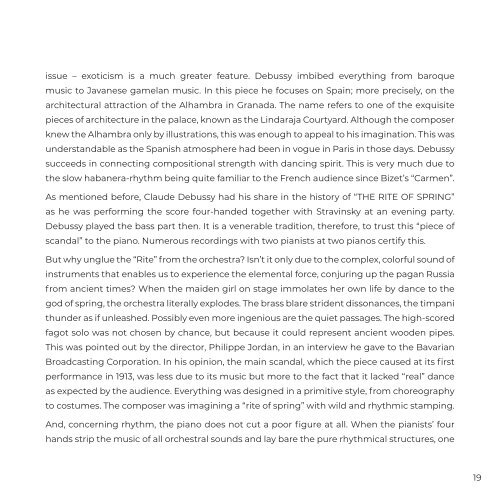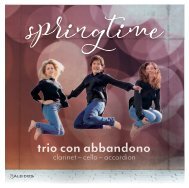Evocation of Dance
TWO4PIANO: EVOCATION OF DANCE // Kontrast- und klangfarbenreich, rhythmisch rasant und komplex! Auf ihrer Debut-CD begeistern die beiden jungen Pianisten Katerina Moskaleva und Alexey Pudinov mit Werken für zwei Klaviere, die sich dem Tanz und dem Rhythmus widmen. Mit einer eleganten Virtuosität, der mitreißenden Spielfreude und ihrem rhythmischen Drive überzeugt TWO4PIANO auf ganzer Linie. Und so wirken die Klangwelten dieser Einspielung wie eine „Beschwörung des Tanzes“ (EVOCATION OF DANCE). // Release: KALEIDOS Musikeditionen, 04/2019, CD-Audio, Jewel-Case, 24-seitiges Booklet (de, en), Art.-Nr.: KAL 6343-2; Edition Portrait Künstler: Katerina Moskaleva, Alexey Pudinov
TWO4PIANO: EVOCATION OF DANCE //
Kontrast- und klangfarbenreich, rhythmisch rasant und komplex! Auf ihrer Debut-CD begeistern die beiden jungen Pianisten Katerina Moskaleva und Alexey Pudinov mit Werken für zwei Klaviere, die sich dem Tanz und dem Rhythmus widmen. Mit einer eleganten Virtuosität, der mitreißenden Spielfreude und ihrem rhythmischen Drive überzeugt TWO4PIANO auf ganzer Linie. Und so wirken die Klangwelten dieser Einspielung wie eine „Beschwörung des Tanzes“ (EVOCATION OF DANCE). //
Release: KALEIDOS Musikeditionen, 04/2019, CD-Audio, Jewel-Case, 24-seitiges Booklet (de, en), Art.-Nr.: KAL 6343-2; Edition Portrait
Künstler: Katerina Moskaleva, Alexey Pudinov
Erfolgreiche ePaper selbst erstellen
Machen Sie aus Ihren PDF Publikationen ein blätterbares Flipbook mit unserer einzigartigen Google optimierten e-Paper Software.
issue – exoticism is a much greater feature. Debussy imbibed everything from baroque<br />
music to Javanese gamelan music. In this piece he focuses on Spain; more precisely, on the<br />
architectural attraction <strong>of</strong> the Alhambra in Granada. The name refers to one <strong>of</strong> the exquisite<br />
pieces <strong>of</strong> architecture in the palace, known as the Lindaraja Courtyard. Although the composer<br />
knew the Alhambra only by illustrations, this was enough to appeal to his imagination. This was<br />
understandable as the Spanish atmosphere had been in vogue in Paris in those days. Debussy<br />
succeeds in connecting compositional strength with dancing spirit. This is very much due to<br />
the slow habanera-rhythm being quite familiar to the French audience since Bizet’s “Carmen”.<br />
As mentioned before, Claude Debussy had his share in the history <strong>of</strong> “THE RITE OF SPRING”<br />
as he was performing the score four-handed together with Stravinsky at an evening party.<br />
Debussy played the bass part then. It is a venerable tradition, therefore, to trust this “piece <strong>of</strong><br />
scandal” to the piano. Numerous recordings with two pianists at two pianos certify this.<br />
But why unglue the “Rite” from the orchestra? Isn’t it only due to the complex, colorful sound <strong>of</strong><br />
instruments that enables us to experience the elemental force, conjuring up the pagan Russia<br />
from ancient times? When the maiden girl on stage immolates her own life by dance to the<br />
god <strong>of</strong> spring, the orchestra literally explodes. The brass blare strident dissonances, the timpani<br />
thunder as if unleashed. Possibly even more ingenious are the quiet passages. The high-scored<br />
fagot solo was not chosen by chance, but because it could represent ancient wooden pipes.<br />
This was pointed out by the director, Philippe Jordan, in an interview he gave to the Bavarian<br />
Broadcasting Corporation. In his opinion, the main scandal, which the piece caused at its first<br />
performance in 1913, was less due to its music but more to the fact that it lacked “real” dance<br />
as expected by the audience. Everything was designed in a primitive style, from choreography<br />
to costumes. The composer was imagining a “rite <strong>of</strong> spring” with wild and rhythmic stamping.<br />
And, concerning rhythm, the piano does not cut a poor figure at all. When the pianists’ four<br />
hands strip the music <strong>of</strong> all orchestral sounds and lay bare the pure rhythmical structures, one<br />
19




